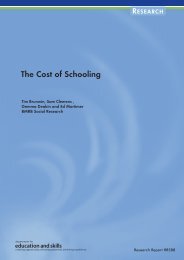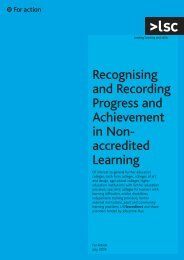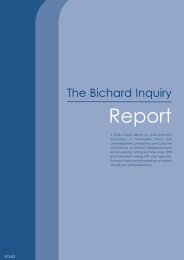What Works for Children with Literacy Difficulties? - Digital ...
What Works for Children with Literacy Difficulties? - Digital ...
What Works for Children with Literacy Difficulties? - Digital ...
You also want an ePaper? Increase the reach of your titles
YUMPU automatically turns print PDFs into web optimized ePapers that Google loves.
(4) Redcar and Cleveland<br />
Very few details were available on this.<br />
Evaluation<br />
However, the LEA had collated data on over 1000 pupils, and the impact was substantial.<br />
Reference<br />
Unpublished data supplied by Andrew Taylor<br />
(5) Worcestershire<br />
Worcestershire began using BRP in 1999, as the approach adopted <strong>for</strong> an Innovative<br />
Development Project (IDP) funded by the Basic Skills Agency. Modifications to the<br />
Brad<strong>for</strong>d model were that the partners were parents, and they were asked to read two books at<br />
each session (not three), and they read <strong>with</strong> children twice a week <strong>for</strong> 15-20 minutes. One<br />
book was familiar, and the second was new, and the new text from each session became the<br />
familiar book <strong>for</strong> the next. In 2000-02, the LEA has trained many parents, and about 60 have<br />
achieved accreditation <strong>for</strong> this work. About 25 schools were using the scheme in 2002; in<br />
addition 10 schools in an Education Action Zone use it <strong>with</strong> teaching assistants.<br />
Evaluation<br />
The 1999-2000 IDP was evaluated by two researchers from the National Foundation <strong>for</strong><br />
Educational Research. The scheme was generally successful, but the LEA adviser<br />
commented (Anthea Main, personal communication, 29 September 2002) that ‘There were<br />
gains across all year groups as long as the children had started reading – it is not successful<br />
<strong>with</strong> non-readers.’<br />
Because the evaluation used a cross-over design, the phase 2 data from the first group to<br />
receive the intervention are effectively follow-up data. The phase 2 data from that group<br />
show that that group continued to make approximately standard progress. They were not<br />
making any further relative gain, but were maintaining the gain made in phase 1.<br />
Reference<br />
Brooks and Hutchison (2000)<br />
23

















